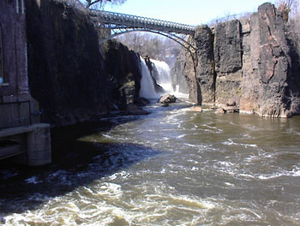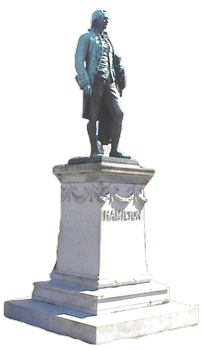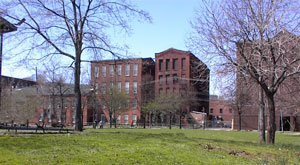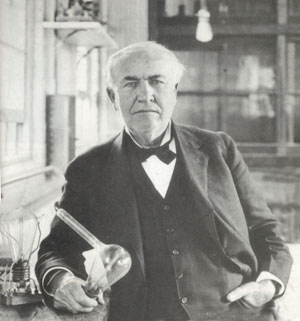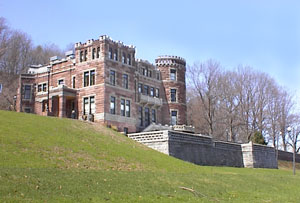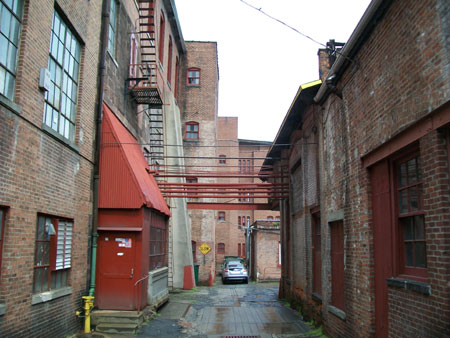 |
|
| Silk
City
-
Paterson,
New
Jersey The Industrial Revolution in North Jersey |
|
| History • American Revolution • Industrial Revolution • Maps |
Paterson was founded in 1791 by the Society for Establishing Useful Manufactures (S.U.M.), a group championed by statesman Alexander Hamilton. The City of Paterson is located in Northeastern New Jersey near waterfalls on the Passaic River. It was incorporated as a town in 1831. The settlement of Paterson, New Jersey, was named for William Paterson, who served as governor of New Jersey and was a signer of the United States Constitution. However, Alexander Hamilton is sometimes called the "Founder of Paterson" because of his vision in July of 1778. While picnicking near the Totowa Falls, Hamilton noticed the natural beauty and power of the "Great Falls." He envisioned a city that would harness the power of the falls to fuel industry. The city grew rapidly, and by 1875, Paterson was known as the Silk City.
The project was off to a rocky start as it coincided with the Panic of 1791-1792. The first mill built was idled in 1796 and destroyed by fire in 1807. The great power of the waterfalls eventually drove Paterson to become one of the first industrial centers in the United States. Engineers, entrepreneurs, artisans and inventors were drawn to this new technology center.
In 1910, S.U.M. convinced the mill owers to switch to electricity. Thomas Edison's Electric Company drew up plans for a 4849 kilowatt hydroelectric facility which operated from 1914 until 1969. In 1984, the plant was restored with the replacement of three of the four turbines. In 1986 the plant was restarted and now generates 11,000 kilowatts per hour, enough electricity for 11,000 homes. Recently the plant produced nearly $400,000 worth of electricity in four months which it sold to Public Service Electric and Gas*. The Great Falls again powers Paterson and the surrounding area today over 223 years since Alexander Hamilton's "picnic".Industry got underway in the Paterson area as a talented machinist named John Clark began operations followed by John Parke. Thomas Rogers started competing against British locomotive manufacturers in 1835. Rogers' firm grew into the leading locomotive manufacturer in the United States by 1854. Inventor John Philip Holland emigrated from Ireland to Paterson in 1873. His idea of an underwater boat was originally rejected by the United States Navy. Privately financed by the Irish Republican Brotherhood, Holland built his submarine boat at an Albany Street ironworks in New York City. The submarine was then moved to J.C. Todd's machine shop in Paterson where it was fitted with the newly patented petroleum engine. In June of 1878, the Holland I was launched from Listers Boathouse above the Great Falls into the Passaic River. By 1870, nearly fifty percent of the silk made in the United States was produced in Paterson. In the early part of the twentieth century, the silk mills of Paterson fell victim to labor strife and never recovered.
An example of the affluence created by Paterson's silk industry can be found just over the city border in Garret Mountain Reservation. Catholina Lambert migrated from England in 1834 and by 1890 was one of the largest mill owners in Paterson. Lambert built his "castle" in 1892 to display his collection of European and American art. Today, the Passaic County Historical Society and the Parks Commission is housed there. Paterson industries provided the sail cloth for Yankee Clipper ships, the revolvers and firearms which tamed the "wild west", locomotives that pulled the freight that built a nation, and silk products which created a golden age for the "Silk City". The history of Paterson and the industrial revolution in America is preserved today as the Great Falls National Historic Landmark. Paterson Art Walk 2013A part of the Great Falls Historic District is dedicated to art studios, performane areas and galleries. On My 25, 2013, an open house of sorts was held inviting visitors into the studios in a historic mill where jute was made into rigging for sailing ships. We took this opportunity to not only view the artworks, but to photograph the 19th century buildings that were part of the Dolphin Jute mills
Pictures
from
the
Paterson
Art
Walk
2013
Related Links:
Sources:
|
||||||||||||||||||||||||||||||
Home • Scenery • History • Recreation • Home & Garden • Directory • Calendar • Classified Ads
• Maps • Scenery • Shopping
Advertise on rt23.com!
• Link to rt23.com!

Questions, comments, corrections? contact the Webmaster
©1999-2008 Ardan Scientific Programming, L.L.C.
